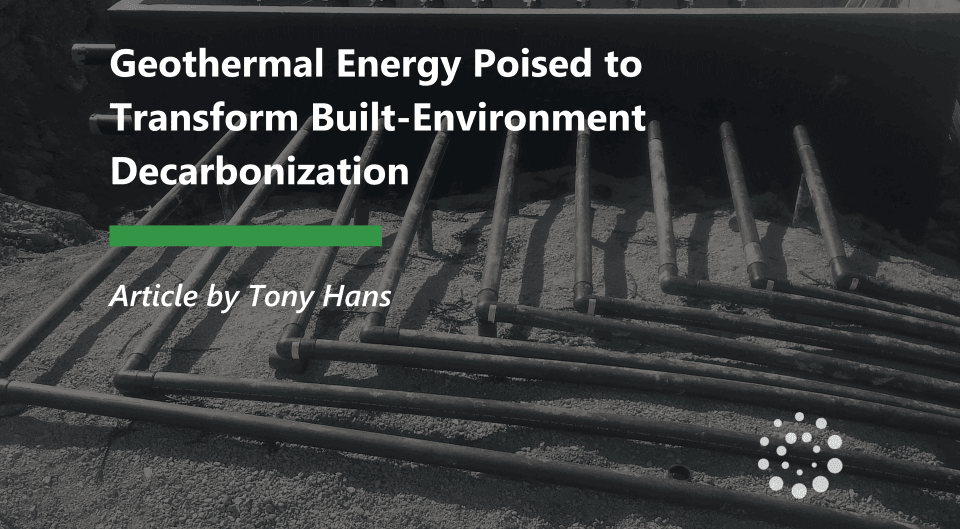By Tony Hans, PE, LEED AP, RCDD
Building owners have a lot of options to consider right now when looking to reduce energy costs and carbon emissions, as there are plenty of technologies that buildings can invest in to help reduce energy consumption. One of the lesser-known ways is to use ground source geothermal for a building’s HVAC. Installed safely underground, ground source geothermal systems are flexible and highly reliable, enabling their use in all manner of buildings, including office spaces, schools, universities, hospitals, federal buildings, and airports. Ground source geothermal has been on the receiving end of praise from the U.S. Environmental Protection Agency (EPA) and Department of Energy (DOE) for decades, underscoring its extensive track record of success. This explains why ground source geothermal is poised to disrupt the built environment’s decarbonization orthodoxy, much to the benefit of building owners and the climate.
A scalable solution
There is no project too big for geothermal tech. Take the Louisville Muhammed Ali International Airport, which recently underwent a large-scale installation. Consisting of 648 underground piping wells, Louisville’s geothermal project delivers reliable, year-round heating and cooling to 400,000 square feet of terminal space while slashing natural gas pollutants and carbon emissions by as much as 80 percent. In addition to drastically improving environmental performance, adopting geothermal guarantees the airport hundreds of thousands of dollars in energy savings each year while providing a more comfortable environment for travelers.
The Riverview Health Westfield Hospital (Riverview Hospital) also offers a glimpse into the benefits of geothermal systems at scale. Spanning more than 105,000 square feet and operating with an energy usage intensity (EUI) of just 96.7 KBTU/SF/YR, Riverview Hospital’s energy costs come in at around $2 per square foot—half that of the median price. One of the most energy-efficient healthcare facilities in the country, Riverview Hospital’s geothermal system mitigates more than 1,500 metric tons of carbon dioxide annually. Additionally, ground source geothermal helped streamline Riverview Hospital’s program and mechanical spaces by way of being more compact and featuring fewer maintenance-requiring pieces of equipment.
When exploring a potential geothermal system, it’s crucial that companies only leverage reputable and experienced firms, as geothermal technology demands a high level of competency. Throughout the highly detailed design process, it’s best to opt for registered mechanical engineering firms that are certified in GeoExchange Design (CGD), as this allows for a greater level of quality control.
The installation process, though relatively standardized, also demands experienced and properly equipped personnel. Only firms with access to geothermal drilling rigs should be contracted, as the right machinery is key to minimizing project liability and timelines. First, 6-inch diameter holes are drilled into the ground (the amount varies by heating and cooling needs), after which u-bent pipes are inserted that carry water into the earth and back up for distribution throughout mechanical rooms. The Earth’s stable underground temperature, which hovers between 53-57 degrees Fahrenheit throughout the year, cools the pumped water in the summertime and heats it during the winter. This allows buildings to maintain comfortable temperatures year-round without fault.
And as ground source geothermal utilizes underground closed water loop systems, it offers unmatched resiliency. Geothermal piping is buried deep below the Earth’s surface, protecting it from harsh weather and other potentially disruptive conditions. This built-in safety means there’s little to no risk of having to replace geothermal technology in the short or long term. Regular inspections and periodic maintenance are enough to keep ground source geothermal systems running like well-oiled machines for decades on end. Finding the right partners who can bring design skills to the project, incorporate federal funding opportunities, and have a test well drilled to better size system capacity and determine thermal conductivity transfer rates are essential to the success of installing ground source geothermal.
The payback
Like many green technologies, the upfront costs of ground source geothermal systems can appear daunting. But dig a little deeper and a different story begins to emerge, especially with building owners now able to leverage IRA subsidies to reduce overall costs by 30 percent. These systems offer energy savings anywhere from 25-50 percent relative to carbon-based alternatives and pay for themselves within just a handful of years—even beating out solar energy. The subsidies don’t last forever, though, with building owners having until December 31, 2032, to claim them.
Embracing ground source geothermal doesn’t just save thousands of dollars, it also positions building owners to capitalize on increased stakeholder sustainability demands. The majority of commercial HVAC systems utilize natural gas boilers or furnaces, degrading indoor air quality and contributing to climate change. Geothermal, on the other hand, omits all combustible fuels and runs entirely on electricity, making it far more efficient. With sustainability a growing focus of global markets, getting ahead of the curve can proactively support ESG initiatives while ensuring regulatory compliance.
The most poignant barrier to ground source geothermal is a building owner’s own assumptions. Many are shocked to learn the extent to which these systems outperform classic HVAC varieties. While there is an upfront cost to the system, they do pay off over time, especially when applying the government subsidies currently available. Forward-looking building owners should explore the possibilities of geothermal, it might just be the best decision they can make for the environment and for their bottom line.
